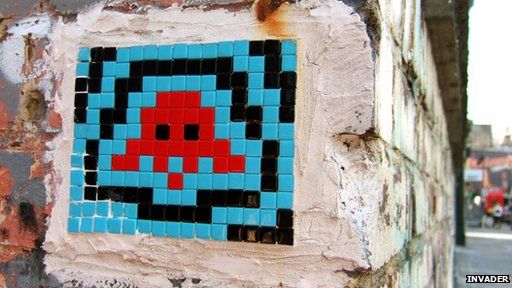Space Invaders: Blast from the past that still inspires
- Published

If you have ever played a video game, you are likely to have seen Taito's Space Invaders or one of its many derivatives.
It may seem prehistoric nowadays, but the title, which is about to celebrate its 35th birthday, has had a huge influence on gaming and the wider world.
It wasn't the first "schmup" - a term used to refer to old-school 2D-scrolling shooter titles. Missile Radar (1974) and Guided Missile (1977) preceded it.
But it did manage to tap into the zeitgeist in a way that others had not.
'Trial and error'
This was in large part because, the year before its release, Star Wars and Close Encounters of the Third Kind had stormed the movie box office, stoking the public's appetite for all things alien.
There was an element of luck that Space Invaders had an extraterrestrial theme.
Tomohiro Nishikado, the game's developer, had originally wanted the game to feature battling tanks or planes. But he switched theme after Taito banned the use of human targets.
"Space Invaders wasn't the result of a sudden flash of inspiration. The concept formed gradually," he tells the BBC.
"Brick-breaking games were very successful at the time, and I wanted to create a shooting game in a similar style. Space Invaders was the result of a great deal of trial and error."
Mr Nishikado was 34 when he designed Space Invaders' gameplay, artwork and sounds as a one-man project. He even built a customised computer to run the game.
"Space Invaders, like all microcomputer-based games of the time, was heavily impacted by hardware limitations and slow processing speeds, so development was a struggle," he says.
Fortunes turned
"The halting movement of the Space Invaders characters was the absolute best I could deliver, but it eventually grew on me."
Space Invaders was initially limited to Japan. It took a few months for mania to ensue, but before long players were standing in line for hours to get a chance to play.
Taito had trouble meeting demand for its arcade machines, and US company Midway spied an opportunity.
It licensed the title and in 1979 launched cabinets featuring the game in the US to great success.
The title also helped jump-start the console industry, which was in the doldrums.
'Revolutionary impact'
A glut of Pong clones - running versions of the bat-and-ball title - had swamped the market for home video games. Manufacturers had slashed prices in an effort to shift stock to the point where they were making losses. Several quit the sector after the crash.
Atari decided to stick it out and the company's fortunes turned when it released a version of Space Invaders in 1980 - the first official licence of an arcade game for a home console.
Space Invaders had a "revolutionary impact", Taito tells the BBC. "It helped lay the foundation for modern video games."
It remains the company's most popular title three-and-a-half decades on, with a thriving merchandise licensing business in addition to new games.
A rhythm-based spin-off, the Groove Coaster Arcade Edition, is being released this year to mark the anniversary.
The game "adjusts with the times", says Taito.
But despite the many updates, it's the original that is held in the highest esteem.
Guinness World Records named it the top-rated arcade game because of its technical, creative and cultural impact.
And the Museum of Modern Art in New York recently announced plans to acquire the game to join its permanent collection.
'Birth of a new art form'
"Space Invaders met the criteria we defined for outstanding interaction design," says Kate Carmody, a curatorial assistant at MoMA's Department of Architecture and Design.
"It is a classic that is important to the history of gaming and technology as well as to the history of electronic interaction design."
It is also part of the curriculum at colleges teaching game design.
"Space Invaders and games like it represent the roots of everything we see today in gaming," says Deus Ex designer Warren Spector, who now teaches at the University of Texas at Austin's Gaming Academy.
"It represents the birth of a new art form, one that literally changed the world. Space Invaders is important as an historical artefact, no less than the silent films of the early 20th Century or early printed books."
The game also inspired Invader, a leading street artist.
The Frenchman - who keeps his identity secret - has pasted a wide variety of Space Invaders-themed mosaics as part of his "attacks" on cities around Europe, Africa, Asia and the Americas.
Targets have included historic buildings in Paris, the Hollywood sign in California and, most recently, walls in east London.
"The characters, which were created at the beginning of the digital technologies, are very low-tech and made with big pixels, which is perfect to be made with real tiles and mosaics like I do," he tells the BBC.
"I guess childhood is a big influence on the future work of many artists.
"Space Invaders represents to me a symbol of the beginning of the digital world in which we are living now."
- Published5 March 2013
- Published5 December 2003
- Published24 December 2009